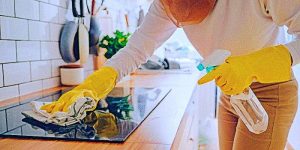 Cleaning the kitchen is generally not a favourite activity for most people. Kitchens however, tend to be some of the dirtiest places in one’s home and they need to be cleaned regularly. By maintaining your kitchen clean at all times, you will ensure that your house is clean and healthy. The conditions in a kitchen are perfect for the growth of all kinds of bacteria and honestly, it is quite gross.
Cleaning the kitchen is generally not a favourite activity for most people. Kitchens however, tend to be some of the dirtiest places in one’s home and they need to be cleaned regularly. By maintaining your kitchen clean at all times, you will ensure that your house is clean and healthy. The conditions in a kitchen are perfect for the growth of all kinds of bacteria and honestly, it is quite gross.
We would like to talk about the best ways to clean all kinds of kitchen cabinets and how often to do that. Back in the day, cabinets were mainly made of wood. However, nowadays most of them are made of eco-friendly materials, plywood or metal. This guide will talk about how to clean all kinds of materials and what would be the best approach depending on the condition of your kitchen cabinets. Of course, you can always call for help a professional cleaning company to do the kitchen cleaning for you.
Note: Even though you might have heard that vinegar is a great all purpose kitchen cleaner, the frequent use of it may harm the surface of your cabinets. Keep reading to find out what better methods to use for different materials.
There are several steps that will apply to any type of kitchen cabinet that you might have:
- Remove all food and dishes from your cabinets. Wipe them down to remove crumbs and other debris. Use a damp cloth or your vacuum cleaner ( if needed ).
- Apply a degreasing solution all over the inside of your cabinet. Avoid over dampening. Let the solution sit for 10 minutes.
- Depending on the material of your cabinets, choose an abrasive or nonabrasive sponge. You can also use a cleaning cloth. Do not use water to dampen the sponge if you’re using an oil-based cleaner.
- Start at the back corner of your cabinet, scrub and pull the dirt and grease forward.
- Right after, use a dry towel to wipe up grease, crumbs and any leftover residue. If your cabinet is especially greasy, repeat the steps.
- Apply the cleaning solution to the outside of your cabinets. Cover their doors, sides, bottom, frame and handle. Follow with a clean dry towel. If the dry towel becomes wet or greasy, replace it with a new one.
Hardwood
Use dry towels, non-abrasive and cellulose or dobie sponges. You can use baking soda, 2:1 dish liquid and water solution; dettol or any multi surface polish cleaner.
Do not use circular motions. Instead, always scrub with the grain of the wood. Only use water-based cleaners for well-finished cupboards. Do not use water-based cleaners if your finish is chipped or damaged. Use a low or neutral pH cleaner to prevent dulling or damage to your wood finish. Make sure to buff it after you’re done cleaning to prevent spotting and streaks.
Plywood
Use a non-abrasive sponge and a low pH cleaner. Plywood is rather common in modern kitchens. It is cheaper and more durable than hardwood. It is however the fastest fading material. Vinegar is too acidic to use on plywood. It will cause it to fade much faster. Avoid high pH cleaners in general. When scrubbing, be as gentle as possible in order to avoid damage to the surface.
Particle Boards
This type of cabinets are usually used in mobile homes and apartments. They usually have wood frames but a particle board carcass. You can use any oil-based cleaner in order to achieve best results. These types of cabinets are easy to clean but difficult to repair. Water destroys the bond that keeps the boards together and might cause sagging of the wood.
Metal
You can use microfiber cloths, abrasive and stainless steel sponges. Metal is compatible with most types of cleaners. Instead of soap and water, try using rubbing alcohol in order to get rid of grease and grime. You can use a stainless steel sponge to clear rust but use a regular abrasive sponge to clean non-rusted metal surfaces. Finish cleaning your metal cabinets by waxing them. Use any type of car/kitchen wax to buff.
Crystal
Use a dry microfiber cloth. You can also use abrasive and cellulose sponges. Clean with baking soda; 2:1 dish liquid and water solution; dettol or any multi surface polish cleaner.
Crystal kitchen cabinets are eco-friendly, non-toxic and environmentally friendly. These cabinets are made from recycled materials. They are made of wood but their finish is similar to lamination. They are susceptible to water damage so avoid over damping them, stainless steel sponges and harsh abrasion.
An important tip!
Once you properly clean your cabinets, depending on what you store in them, as well as how many people live in your house, you may need to wipe them at least once a week. Create a cleaning schedule or draw a weekly plan and always include your kitchen cabinets. Make sure you remove any debris and crumbs and regularly check for expired products and foods. Regular cleaning will prevent your cabinets from becoming filthy and greasy.
